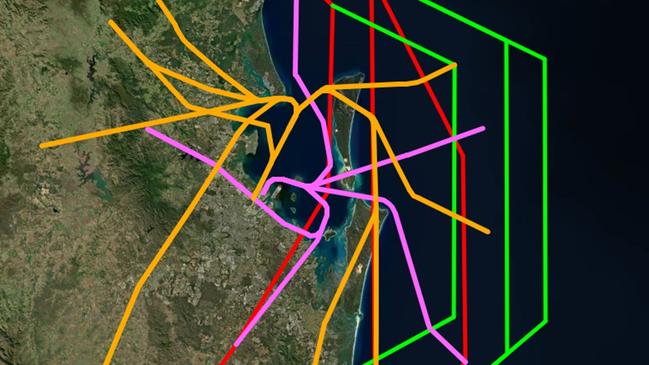Brisbane flight path changes push more aircraft out to sea
The new measures would see more simultaneous day and night-time take offs and landings coming in and out over Moreton Bay.
Business
Don't miss out on the headlines from Business. Followed categories will be added to My News.
Proposed new flight paths for Brisbane Airport have been released in response to community outrage over excessive noise following the opening of a second runway in 2020.
Flight paths associated with the parallel runway send aircraft over many of Brisbane’s riverfront suburbs, which were previously unbothered by jet engine and turboprop noise.
Airservices Australia was responsible for designing the flight paths, but admitted it basically relied on the suggestions of Brisbane Airport Corporation.
“When we did the final flight path design in 2017-18, we adhered pretty closely to the flight paths that were approved through Brisbane Airport’s master plan,” said Airservices head of community engagement Donna Marshall.
“We have a standard practice that 12-months after we implement any major flight path changes we hold a review, and the community input to that has been quite significant. We’ve had a large number of complaints from Brisbane residents about aircraft noise.”
As a result, Airservices was proposing to spread the noise over more suburbs in the city’s north and northwest by rotating flight paths on a nightly basis.
Another measure would see more daytime as well as night-time flights come in and go out over Moreton Bay, using a practice known as “simultaneous opposite direction parallel runway operations” or SODPROPS.
Ms Marshall said the main barrier to SODPROPS was weather, with conditions required to be clear, dry and fairly still.
“With SODPROPS you effectively have aircraft pointed at each other when they’re arriving and departing — one’s departing over the bay, and one’s arriving,” she said.
“They’re separated by 2km because of the runway configuration, but there is a requirement to have good visibility and the runway surface must be dry.”

Another impediment was air traffic congestion in the daytime, but Ms Marshall said that could be overcome by pushing flights passing through Brisbane airspace further out to sea.
Airservices noted that such a move would add up to 37 nautical miles to flights, and create about 700kg more carbon emissions per service.
“It’s very difficult to make noise improvements and avoid communities without adding some track miles,” Ms Marshall said.
“CO2 emissions are an important factor and for our airline customers, fuel burn is also an important factor.”
Community members were being invited to comment on the proposals, and attend one of 14 “drop in” sessions across the city or an online session.
Brisbane Flight Path Community Alliance chair Marcus Foth said the changes were simply a “shuffling of the deck chairs on the Titanic” that would have minimal benefit to residents.
“In essence the community does not believe Airservices is the right entity to do anything in this space primarily because there is a conflict of interest,” said Professor Foth.
“Airservices is a corporatised entity that has as its main mode of operation, the collection of levies from airlines and airports and because of those commercial interests, community protection has really fallen by the wayside.”
He was also concerned about the “small print” and “strings attached” to the proposals, which indicated it would be 12 to 18-months before communities noticed any change.
“We believe the severity and magnitude of this problem has not been recognised yet,” Professor Foth said.
Simmering anger about the issue was seen as a factor in the Greens’ success in three inner Brisbane seats at the last federal election.
Member for Griffith Max Chandler-Mather, who ousted Labor’s Terri Butler, continued to advocate for a curfew on Brisbane Airport to appease constituents.
Transport Minister Catherine King has ruled out such a restriction or a flight cap in Brisbane, similar to that in Sydney, saying it would have “significant economic consequences”.
Brisbane Airport Corporation head of public affairs Stephen Beckett welcomed the Airservices’ proposals and encouraged residents to have their say.
More Coverage
Originally published as Brisbane flight path changes push more aircraft out to sea





